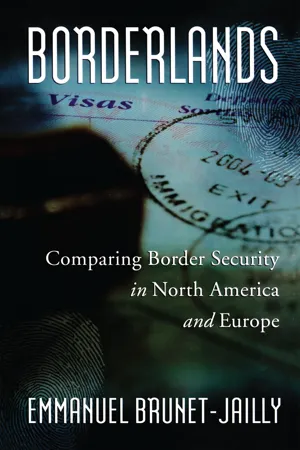
- 406 pages
- English
- ePUB (mobile friendly)
- Available on iOS & Android
Borderlands
About This Book
Border security has been high on public-policy agendas in Europe and North America since the September 11, 2001 attacks on the World Trade Centre in New York City and on the headquarters of the American military in Washington DC. Governments are now confronted with managing secure borders, a policy objective that in this era of increased free trade and globalization must compete with intense cross-border flows of people and goods. Border-security policies must enable security personnel to identify, or filter out, dangerous individuals and substances from among the millions of travelers and tons of goods that cross borders daily, particularly in large cross-border urban regions.
This book addresses this gap between security needs and an understanding of borders and borderlands. Specifically, the chapters in this volume ask policy-makers to recognize that two fundamental elements define borders and borderlands: first, human activities (the agency and agent power of individual ties and forces spanning a border), and second, the broader social processes that frame individual action, such as market forces, government activities (law, regulations, and policies), and the regional culture and politics of a borderland.
Borders emerge as the historically and geographically variable expression of human ties exercised within social structures of varying force and influence, and it is the interplay and interdependence between people's incentives to act and the surrounding structures (i.e. constructed social processes that contain and constrain individual action) that determine the effectiveness of border security policies.
This book argues that the nature of borders is to be porous, which is a problem for security policy makers. It shows that when for economic, cultural, or political reasons human activities increase across a border and borderland, governments need to increase cooperation and collaboration with regard to security policies, if only to avoid implementing mismatched security policies.
Frequently asked questions
Information
Table of contents
- Cover
- Title Page
- Copyright
- Contents
- Preface
- Acknowledgements
- Introduction: Borders, Borderlands, and Porosity
- Chapter 1. The Maritime Borders of Europe: Upstream Migratory Controls
- Chapter 2. Whose Security? Dilemmas of US Border Security in the Arizona-Sonora Borderlands
- Chapter 3. Border Acrobatics between the European Union and Africa: The Management of Sealed-off Permeability on the Borders of Ceuta and Melilla
- Chapter 4. Fayuca Hormiga: The Cross-border Trade of Used Clothing between the United States and Mexico
- Chapter 5. A New Northern Security Agenda
- Chapter 6. From Iron Curtain to Paper Wall: The Influence of Border Regimes on Local and Regional Economies—The Life, Death, and Resurrection of Bazaars in the Lódz Region
- Chapter 7. The Economic Cost of Border Security: The Case of the Texas-Mexico Border and the US VISIT Program
- Chapter 8. The Costs of Homeland Security
- Chapter 9. Managing US-Mexico Transborder Cooperation on Local Security Issues and the Canadian Relationship
- Chapter 10. Anti-terrorism in North America: Is There Convergence or Divergence in Canadian and US Legislative Responses to 9/11 and the US-Canada Border?
- Chapter 11. The Southern Border of Mexico in the Age of Globalization
- Chapter 12. Conclusion: Borders, Borderlands, and Security: European and North American Lessons and Public Policy Suggestions
- List of Contributors
- Index